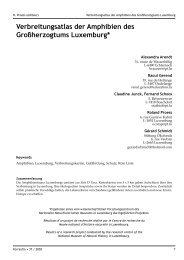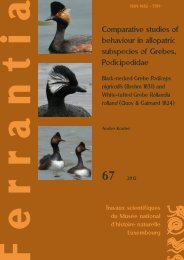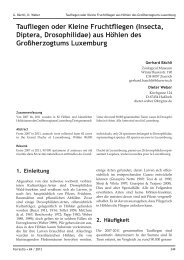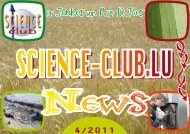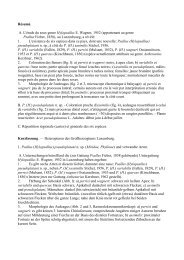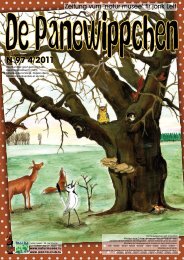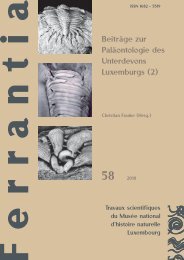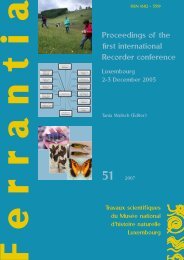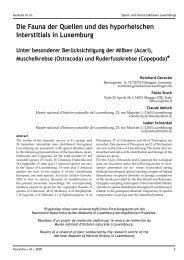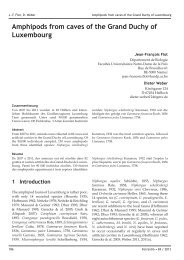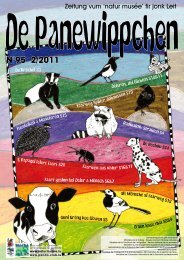Ferrantia 66 Die Graslandgesellschaften Luxemburgs
Ferrantia 66 Die Graslandgesellschaften Luxemburgs
Ferrantia 66 Die Graslandgesellschaften Luxemburgs
Erfolgreiche ePaper selbst erstellen
Machen Sie aus Ihren PDF Publikationen ein blätterbares Flipbook mit unserer einzigartigen Google optimierten e-Paper Software.
S. Schneider <strong>Die</strong> <strong>Graslandgesellschaften</strong> <strong>Luxemburgs</strong><br />
The Polygalo-Nardetum, the Geranio sylvatici-<br />
Trisetetum, the Festuca rubra-Agrostis capillariscommunity<br />
and the Carex rostrata-community can<br />
thus only be found in the north. The Filipendula<br />
ulmaria-community, the Scirpus sylvaticuscommunity<br />
and the Bistorta officinalis-community<br />
are characteristic for fallow brook valleys in the<br />
Ösling. The sharp-flower rush-meadow (Crepido-<br />
Juncetum acutiflori) is one of the most frequent wet<br />
meadow associations in the Ösling.<br />
The Calthion-alliance-community, the Bromo-<br />
Senecionetum aquatici and the Carex distichacommunity<br />
are widely spread in the Gutland.<br />
Flood-lawn-communities (above all the Ranunculo-<br />
Alopecuretum geniculati), the Caricetum nigrae<br />
and Large Sedge fens like Caricetum gracilis and<br />
Carex acutiformis-community are interlocked with<br />
Calthion meadows on a small scale. The Angelico-<br />
Cirsietum oleracei is one of the rarest Calthionassociations<br />
of Luxembourg. The Dry Brome<br />
swards (Bromion-alliance-community) as well as<br />
the Salvia-False Oatgrass meadows are limited<br />
on the milder climate and the base-rich shelly<br />
limestone and marly Keuper soils in the eastern<br />
and central part of the country.<br />
The influence of subatlantic climate on the study<br />
area shows in the species composition of specific<br />
plant communities as well as in their frequency or<br />
rarity.<br />
Grassland habitats worthy of protection in Europe<br />
are also rare and endangered in Luxembourg.<br />
These are Matgrass swards, Purple Moorgrass<br />
meadows, Dry Brome swards, Yellow Oatgrass<br />
meadows and species-rich False Oatgrass<br />
meadows. Furthermore the Small Sedge fens,<br />
Large Sedge fens as well as species-rich wet<br />
meadows and their fallow stages are endangered<br />
in Luxembourg. Some grassland communities are<br />
only found well developed in protected areas. The<br />
nature conservation evaluation covers generally<br />
valid land use recommendations, which are meant<br />
to contribute to the preservation of these increasingly<br />
rare grassland communities and their flora.<br />
The present monograph on grassland vegetation<br />
is meant to serve as a basis for nature conservation<br />
planning.<br />
214<br />
8. Literaturverzeichnis<br />
Administration du cadastre et de la topographie<br />
du Luxembourg 2000. - Plan BD-L-TC<br />
1996-2000. Topographische Karte (digital).<br />
Administration des eaux et forêts du grand-duché<br />
de Luxembourg (Hrsg.) 1995. - Naturräumliche<br />
Gliederung <strong>Luxemburgs</strong>. Ausweisung ökologischer<br />
Regionen für den Waldbau mit Karte<br />
der Wuchsgebiete und Wuchsbezirke, 71 S.<br />
Administration des ponts et chaussées, Service<br />
géologique 2006. - Carte géologique du<br />
Luxembourg. Vecteur-Image Version 1.1 vom<br />
27.11.2006.<br />
Aendekerk R. & Gawalowski G. 1991. - <strong>Die</strong><br />
Vegetation der Wiesen und Weiden in<br />
„Lannebur“/Aspelt, Naturschutz und Bewirtschaftung.<br />
- Dossier de classement. - unveröffentl.<br />
Studie, Fondation Hëllef fir d'Natur,<br />
Luxembourg. 44 S.<br />
Aendekerk R. & Heidt J.-C. 1991. - Einfluß der<br />
Mahd auf die Vegetation des Naturschutzgebietes<br />
Grosbous „Neibruch“. Zwischenbericht<br />
1991. - unveröffentl. Studie, Fondation<br />
Hëllef fir d'Natur, Luxembourg. 6 S.<br />
Aendekerk R., Mersch C. & Moes G. 1990. -<br />
Grünlandwirtschaft und Naturschutz in den<br />
Ardenner Tälern - am Beispiel von Dellen/<br />
Luxemburg. - unveröffentl. Studie, Fondation<br />
Hëllef fir d'Natur, Luxembourg. 61 S. + Anhang.<br />
Aendekerk R. & Thiel M. 2004. - Grünlandkartierung<br />
der Gemeinde Schuttrange. 2003 - 2004<br />
- unveröffentl. Studie, Biologische Station -<br />
Naturzenter SIAS, Senningerberg. 569 S. +<br />
Anhang.<br />
Amani M.R. 1980. - Vegetationskundliche und<br />
ökologische Untersuchungen im Grünland<br />
der Bachtäler um Suderburg. - Diss. Univ.<br />
Göttingen. 116 S.<br />
Apitzsch M. 1963. - Rotschwingel-Straußgraswiesen<br />
des Altenberger Gebietes und ihre<br />
Entwicklungstendenzen. - Berichte der Arbeitsgemeinschaft<br />
Sächsischer Botaniker N. F. 5/6:<br />
183-214. Dresden.<br />
Balátová-Tuláčková E. 1976. - Rieder- und Sumpfwiesen<br />
der Ordnung Magnocaricetalia in der<br />
Záhorie-Tiefebene und dem nördlich angren-<br />
<strong>Ferrantia</strong> • <strong>66</strong> / 2011



